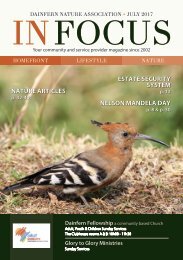Deckle Edge Media_Maluti_Issue 1 Winter 2017
Community magazine: From the hearts and homes in the Eastern Free State
Community magazine: From the hearts and homes in the Eastern Free State
Create successful ePaper yourself
Turn your PDF publications into a flip-book with our unique Google optimized e-Paper software.
Crossroads<br />
Harrismith<br />
Blankets & Timber<br />
By SILMA BADENHORST<br />
Harrismith was founded in 1849 after the town has been initially laid out by Robert Moffat about 25 kilometres<br />
from the current location, in present-day Aberfeldy on the Elands River. That site, however, proved to be<br />
deficient in water and Harrismith was shifted to its present site twenty-four years later during the diamond<br />
rush at Kimberley. British Governor, Harry Smith, requested Paul Michiel Bester to choose a better site that<br />
would be well suited for a town in the North Eastern Free State. It was therefore named after Sir Harry Smith.<br />
Bester chose well when he decided the best site would be at the<br />
foot of the towering Platberg (i.e. “flat/flat-topped mountain”<br />
when translated from Afrikaans), which is 9 kilometres long, 2 394<br />
metres high and on the banks of the Wilge River. The town became<br />
a busy staging post on the Natal transport route. As a direct result<br />
of this, hotels, stores and public buildings shot up. Few towns are<br />
situated in such beautiful surroundings. By the 1880s the town<br />
was the second largest in the Orange Free State.<br />
In those days, the town stood on the frontier of civilization: to the<br />
North was the unexplored Transvaal and to the east Natal, largely<br />
undeveloped with several tribes of Zulus that were very dangerous<br />
and farming operations were impossible. Because of this, the town<br />
was involved in most of the “Bantu Wars” (nine wars or flare-ups<br />
from 1779 to 1879) and the site of the present high school held<br />
the town fort. The town was surrounded by stone ramparts that<br />
were removed only recently, despite the protests of those who<br />
realized the historical value.<br />
“In those days, the town stood on the frontier of<br />
civilization: to the North was the unexplored<br />
Transvaal and to the east Natal ...”<br />
Harrismith developed slowly and at the outbreak of the Anglo Boer<br />
War (1899 to 1902) it was little more than a village, with English<br />
speaking residents. The first town council, except for Thys Wessels,<br />
were all from British descent. During this time, the Harrismith<br />
Commando was the first in the battlefield. It was also the first to be<br />
engaged in a skirmish with the British forces at Bester’s Station and<br />
lost the first civilian, who could hardly speak a word of Afrikaans<br />
– a man named Fred Johnson. The remnants of the Harrismith<br />
Commando were with General De Wet until the end and were<br />
part of those civilians that were nicknamed the “Bitter-enders”,<br />
because some of them only surrendered after the signing of the<br />
Treaty of Vereeniging.<br />
[Above] Late afternoon view of Harrismith, seen from north of town along the N3 freeway, looking south. The outline of the <strong>Maluti</strong> range (on the Lesotho<br />
border) can be seen. A large part of town is out of view to the right / [Page 7] Platberg (By JMK (2013) Wikimedia.org).<br />
<strong>Maluti</strong> Berg & Dal • <strong>Winter</strong> <strong>2017</strong> • 5





